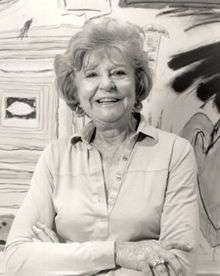Ida Kohlmeyer
Ida Rittenberg Kohlmeyer (3 November 1912 – 29 January 1997) was an American painter and sculptor who lived and worked in Louisiana. Kohlmeyer took up painting in her 30s and achieved wide recognition for her work in art museums and galleries throughout the United States.[2] Notably, her work is held by the National Museum of Women in the Arts,[3] the Smithsonian American Art Museum, the Ogden Museum of Southern Art and the New Orleans Museum of Art. Ms. Kohlmeyer, a member of the Reform Jewish movement, played an active role in the New Orleans Jewish community throughout her life. Touro Synagogue (New Orleans) displays much of her artwork in their synagogue and in the social hall.
Ida Kohlmeyer | |
|---|---|
 | |
| Born | Ida Rittenberg[1] November 3, 1912 New Orleans, Louisiana |
| Died | January 29, 1997 (aged 84) New Orleans, Louisiana |
| Nationality | American |
| Education | Sophie Newcomb Memorial College at Tulane University |
| Known for | Painting, Sculpture |
| Spouse(s) | Hugh Kohlmeyer[1] |
Early life
Kohlmeyer, née Rittenberg, was the daughter of Polish immigrants. She earned a Bachelor of Arts in English at Newcomb College, the former women's coordinate college of Tulane University. She became interested in art during her honeymoon in Mexico, during which she was drawn to the ceramic folk art of Central and South America.[2]
Early art career, 1950s
Kohlmeyer returned to Newcomb/Tulane in 1950 and completed a Master of Fine Arts in painting in 1956.[4] She then studied at the painting school of the New York artist Hans Hofmann, known for his use of color, who influenced her in her decision to give up representational art for abstraction.[5] Her early work was primarily in a gestural style influenced by Holfmann and other Abstract Impressionists, including Arshile Gorky and Mark Rothko, whom she met in New York. She had her first exhibition at the New Orleans Museum of Art in 1957, and her first exhibition in New York City at the Ruth White Gallery in 1959.[2]
Later art career, 1970s–1980s
Kohlmeyer, inspired by her interest in South American art and the work of Miró developed "...a distinctive vocabulary of hieroglyphs, shapes, and signs, all organized in a loose grid, that hovered among abstraction, writing and emblem."[2] She explored this style throughout her life. The Atlanta High Museum of Art hosted a retrospective of her work in 1972, as did the Mint Museum of Art in Charlotte, NC, which traveled to seven cities in 1984 and 1985.[2]
The New Orleans Museum of Art celebrated 100 years of Kohlmeyer's career in 2012-2013.[6]
References
- Smith, Roberta. "Ida Kohlmeyer, 84; Known as Pictographic Painter". New York Times. Retrieved 13 June 2017.
- Smith, R. (1997, January 26). Ida Kohlmeyer, 84, a painter known for pictographic works. The New York Times.
- "Artist Spotlight: Ida Kohlmeyer (American, 1912-1997)". Broad Strokes: The National Museum of Women in the Arts' Blog. 2009-09-11. Retrieved 2017-04-20.
- "Ida Kohlmeyer". www.knowla.org. Retrieved 3 March 2016.
- Marter, Joan M., and Gwen Finkel Chanzit (2016). Women of Abstract Expressionism. Denver: Denver Art Museum. pp. 182. ISBN 978-0-300-20842-9.
- "Ida Kohlmeyer: 100th Anniversary Highlights | New Orleans Museum of Art". New Orleans Museum of Art. Retrieved 2017-04-20.